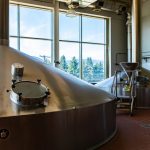
Sulphur dioxide is an extremely important compound in beer, wine and cider. It has three key roles (Dvořák et al. 2006):-
- It reacts with carbonyl compounds to form α-hydroxysulphonates. These α-hydroxysulphonates are not flavour active but can increase the flavour threshold of carbonyl compounds responsible for their stale flavour. They are important quality compounds.
- It serves as a general antioxidant and so inhibits oxidative reactions.
- It behaves as an antimicrobial at high concentrations (Ilett, 1995).
In solution, sulphur dioxide exists in several forms (SO2.H2O, HSO3– and SO32–) depending on the pH of the solution. At the usual pH of beers between 3.8–4.4, SO2 is present mostly as HSO3– (bisulphite or hydrogen sulphite anion). At low pH values, SO2 is weakly bound to water as SO2.H2O (Almeida et al., 2003). Sulphur dioxide is present partially in a free form in beer, but mostly linked to carbonyl compounds (Guido, 2005) which would include aldehydes, ketones, especially any acetone. It is also speculated to reduce the flavour impact of these molecules and even reduce taints or off-notes because of this property.
The chemistry and measurement of sulphur dioxide is admirably reviewed by (2006) and much of this short post gives a precis of their work.
Sulphur dioxide in beer originates primarily from yeast metabolism unless it has been deliberately added. Sulphate in the fermentation medium is reduced to sulphite, which is metabolised to synthesise amino acids and this pathway is controlled by feedback inhibition. If more sulphite is produced than is needed for amino acid synthesis, the excess is released into beer (Ilett, 2003). Controlling the sulphite content in the fermentation medium is of paramount importance to reduce the opportunity for generating taints and off notes.
The SO2 in beer can also come from addition of sulphiting agents. According to the European Commission’s Scientific Committee on Food (SCF) there is an acceptable daily intake (ADI) of 0.7 mg/kg body weight /day for sulphur dioxide and its equivalents (Guido, 2003). The SO2 level is controlled at the end of beer production to meet requirements for human health because of the susceptibility to asthma attack and beer quality in general. The European Union established a maximum permitted level of total SO2 in beer of 20 mg/L (EU, 2000, 2003) whilst in the USA, the maximum level of total SO2 is 25 mg/L (Ilett, 2003). Levels of SO2, which are higher than 10 mg/L must now be labelled (EU, 2000, 2003). A warning that sulphites are present must also be printed on the label and be clear.
There are many methods for the determination of total sulphur dioxide in beer. The most frequently used are the three methods recommended by the European Brewery Convention (EBC): EBC methods, 9.25.1. – Total Sulphur Dioxide in Beer: Distillation Method (EBC, 2005a) whose origin is the Monier-Williams method (Monier-Williams, 1927), 9.25.2 – Total Sulphur Dioxide in Beer: Enzymatic Method (EBC, 2005b) which is now archived and 9.25.3 – Total Sulphur Dioxide in Beer: p-Rosaniline (EBC, 2005c). The same methods or slightly modified methods are also recommended by the American Society of Brewing Chemists (ASBC, 2004), the Institute of Brewing (IOB, 1997a & b) and by Mitteleuropäische Brautechnische Analysen Kommission (MEBAK, 2003a & b).
The Monier-Williams method (EBC, 2005a; Monier-Williams, 1927) requires the distillation of SO2 from an acidified beer sample under an inert atmosphere of nitrogen and carbon dioxide at 100°C. The SO2 is collected in a hydrogen peroxide solution where it is converted to sulphuric acid, which is then titrated with NaOH. It has been widely applied but unfortunately is regarded as too time consuming for routine analysis. There are many modifications of the Monier-Williams method, but all exploit the same chemical principles.
The Ripper method was designed to supercede the Monier-Williams method and is a direct iodometric titration which suffers interference from iodine-reactive compounds and has been strongly criticized (Maquieira et al. 1993). In general, iodometric methods which are common simplifications of the Ripper method are preferred by the wine industry (Azevedo et al., 1999). For the determination of free SO2, the sample is acidified and is titrated with a standard iodine solution, using starch as the indicator. For the determination of total SO2, the sample is previously treated with sodium hydroxide to release the bound SO2. The results should be interpreted with caution because of the solutions’ poor stability, the possible occurrence of parallel reactions and additional difficulties associated with the end point observation, especially in the case of the red wines (Azevedo et al. 1999).
A very well regarded determination of SO2 uses DTNB (5,5-dithiobis(2-nitrobenzoic acid)). Sulphur dioxide is stripped by nitrogen from the acidified sample into a buffered DTNB solution and the absorbance is measured at 415 nm (Guido, 2005).
Another spectrophotometric colorimetric determination of SO2 is based on the reaction between SO2 , p-rosaniline and formaldehyde. On completing the reaction and development of the colour (30 min), absorbance of the p-rosaniline-sulphite complex at 550 nm is measured (EBC, 2005c; ASBC, 2004; IOB, 1997b).
The enzymatic assay uses the enzyme sulphite-oxidase (SO2-OD) and the determination is based on the oxidation of sulphite by oxygen in the presence of this catalyst. The hydrogen peroxide formed in this reaction is reduced by nicotinamide adenine dinucleotide (NADH) in the presence of the enzyme NADH-peroxidase. The concentration of sulphite is calculated from the changes in the NADH absorbance at 340 nm (EBC, 2005b; MEBAK, 2003a).
Nowadays, flow injection analysis (FIA) methods have been developed. A sample is injected into a carrier stream, which is merged and mixed with a reagent stream. Products of reaction are quantified using flowthrough detectors. These methods are mostly adaptations of other existing methods (Fernandes et al., 1998).
Ion exclusion chromatography with electrochemical detection appears far simpler and faster than the Monier-Williams technique. The results of chromatographic analysis correlated well with those obtained by the p-rosaniline technique. The method normally utilizes pulsed amperometric detection (Wagner et al., 1991).
SO2 can be also determined by headspace gas chromatography using a flame photometric detector(FPD). SO2 is trapped by tetrachloromercurate ions. This method is calibrated using a separately prepared standard curve (Manur, 1994). Infrared spectroscopy also provides one method of determination, which is based on the absorption at a single molecular line of the sulphur dioxide molecule (Skands et al., 2003). Voltammetric determination of sulphur dioxide and acetaldehyde was first presented at the EBC Congress in Budapest in 2001 by Barros et al. (2001). First, the beer sample was diluted and made alkaline by the addition of NaOH, this caused the decomposition of adducts between SO2 and carbonyls, and conversion of the hydrogen sulphite to sulphite. Then volatile aldehydes were transferred by nitrogen gas to a 0.1 M acetate supporting electrolyte (pH 4) containing 0.02 M hydrazine dihydrochloride. Aldehydes were converted to hydrazones, which were then voltammetrically determined. The remaining beer was acidified with HCl to convert all sulphite into SO2. SO2 is then transferred by an inert carrier gas such as nitrogen into a trapping solution (0.1 M acetate buffer, pH 5.0) in a voltammetric cell, where its concentration was determined. Free sulphur dioxide is estimated as the difference between the total SO2 and the acetaldehyde concentration (Almeida et al., 2003a & b, Barros et al., 2001; Guido et al., 2003).
References
Almeida, P.J., Rodrigues, J.A., Guido, L.F., Santos, J.R., Barros, A.A. and Fogg, A.G. (2003a) Voltammetric determination of free and total sulphur dioxide in beer. Electroanalysis, 15(5–6), pp. 587–590
Almeida, P.J., Rodrigues, J.A., Guido, L.F., Santos, J.R., Barros, A.A. and Fogg, A.G., Voltammetric determination of free and total sulphur dioxide in beer. Electroanalysis, (2003b) 15(5–6), pp. 587–590.
ASBC (2004) ASBC Methods, Beer 21 – Total sulphur dioxide, 9th Edition, American Society of Brewing Chemists, The Society: St. Paul, MN.USA.
Azevedo, C., Araki, K., Toma, H., Angnes, L. (1999) Determination of sulfur dioxide in wines by gas-diffusion flow injection analysis utilizing modified electrodes with electrostatically assembled films of tetraruthenated porphyrin. Anal Chim Acta. 387 pp. 175-180.
Barros, A.A., Rodrigues, J.A., Almeida, P.J., Guido, L.F., Golçalves, P., Santos, J.R., Machado-Cruz, J.M. and Fereira, A. (2001) Application of voltammetry in beer analysis. Proceedings of the European Brewery Convention Congress, Budapest, Fachverlag Hans Carl: Nürnberg, Germany, CD ROM 2001, Contribution 84.
Dvorak, J., Dostalek, P., Sterba, K., Cejka, P., Kellner, V., Culik, J., et al. (2006). Determination of Total Sulphur Dioxide in Beer Samples by Flow-Through Chronopotentiometry. J. Institute of Brewing, 112, pp. 308–313
EU (2000) Directive 2000 /13/EC of the European Parliament and the Council of the Approximation of the Laws of the Member States Relating to the Labelling of Foodstuffs. 20.3.2000.
EU (2003) Directive 2003 /89/EC of the European Parliament and the Council Amending Directive 2000 /13/EC as Regards Indication of the Ingredients Present in Foodstuffs. 10.11.2003.
EBC (2005a) Analytica EBC, 9.25.1. – Total sulphur dioxide in beer: Distillation method. European Brewery Convention, 5th update, Verlag Hans Carl Getranke-Fachverlag: Nürnberg, Germany.
EBC (2005b) Analytica EBC, 9.25.2. – Total sulphur dioxide in beer: Enzymatic method. European Brewery Convention, 5th update, Verlag Hans Carl Getranke-Fachverlag: Nürnberg, Germany.
EBC (2005c) Analytica EBC, 9.25.3 – Total sulphur dioxide in beer: p-Rosaniline method. European Brewery Convention, 5th update, Verlag Hans Carl Getranke-Fachverlag: Nürnberg, Germany.
Fernandes, S.M.V., Silvia, M.V., Rangel, A.O.S.S. and Lima, J.L.F.C. (1998) Determination of total sulphur dioxide in beer by flow injection spectrophotometry using gas-diffusion and the merging zones technique. J. Inst. Brew., 104(4), pp. 203–205.
Guido, L.F. (2005) How do sulphites help to control beer ageing? Cerevisia, 30(2), pp. 132–137
Guido, L.F., Fortunato, N.A., Rodrigues, J.A. and Barros, A.A. (2003) Voltammetric assay for the aging of beer. J. Agric. Food Chem., 51(14), pp. 3911–3915
Ilett, D.R. (1995) Aspects of the analysis, role, and fate of sulphur dioxide in beer – a review. Tech. Q. Master Brew. Assoc. Am., 32(4), pp. 213–221.
IOB (1997a) Institute of Brewing, Methods of Analysis, 9.18 – Total Sulphur Dioxide in Beer: Distillation Method (EM) Institute of Brewing: London, UK.
IOB (1997b) Anonymous. Institute of Brewing, Methods of Analysis, 9.19 – Total Sulphur Dioxide in Beer: p-Rosalinine Method, Institute of Brewing: London, UK.
Manur, M., Maurice, M.-J. and Kluessendorf, A. (1994) Quantitation of sulphur dioxide residues in malt and beer by headspace gas chromatography. J. Am. Soc. Brew. Chem., 52(4), pp. 168–171.
Maquieira, A., Casamayor, F., Puchades, R., Sagrado, S. (1993) Determination of total and free sulphur dioxide in wine with a continuous-flow microdistillation system. Anal. Chim. Acta. 283 pp. 401-407.
MEBAK (2003a) Brautechnische Analysenmethoden, 2.25.1 – Enzymatische Methode Band II, 2002, MEBAK Freising-Weihenstephan: Germany.
MEBAK (2003b) Brautechnische Analysenmethoden, 2.25.2 – Destillation-Methode (EBC – Methode) Band II, 2002, MEBAK Freising-Weihenstephan: Germany.
Monier-Williams, G.W. (1927) Determination of sulfur dioxide in foods. Brit. Food J., 29, pp. 51–53.
Skands, B., Pedersen, K., Lund, M. and Petersen, T. (2003) Improved SO2 control with a new method for at-line measurement. Proceedings of the European Brewery Convention Congress, Dublin, Fachverlag Hans Carl: Nürnberg, Germany, CD ROM 2003, Contribution 67.
Wagner, H.P. and McGarrity, M.J. (1991) Determination of sulphite in beer using ion-exclusion chromatography and pulsed amperometric detection. J. Am. Soc. Brew. Chem., 50(1), pp. 1–3 (Article)

Have you looked at Thermo Fisher Scientific for their application method? They have some useful kit for wines in particular. We use their stuff for glycerol, heavy metal measures and vinegar notes – I believe it’s acetaldehyde. I’ve also looked at some Waters kit in the past but we haven’t got round to trying it out yet. ATB Paul